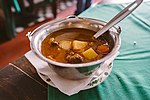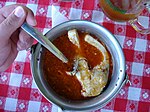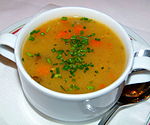Drevstranese cuisine
Drevstranese cuisine describe the various cullinary styles found across the modern days country of Drevstran. It can vary widely from region to region, but it is generally admitted all of these styles find their characteristics from three original sources : Gothic, Ludic, and Lush - or Steppe - cuisine. All and all, Drevstran cuisine is primarily based on meats, seasonal vegetables, fruits, bread, and dairy products.
General Features
Bread is perhaps the most important and basic part of the Drevstranese diet and has always been. It is eaten at all meals, accompanying main dishes. "Main Dishes" are generally a water-based soup, stew, or broth which can either be vegetarian or with lamb, goat meat, veal, chicken or pork.. The most famous of these is the Gulyasleves (lit. "Soup of the Herd"), the stapple meal of the Lushyod herdsmen who brought it everywhere they settled, both in the Lushyodorstag and the Kingdom of the Drev. At that time, the cooked and flavored meat was dried with the help of the sun and packed into bags produced from sheep's stomachs, needing only water to be turned into a meal.
It is considered unacceptable to serve main dishes without a Side Dish to accompany it. These include various kinds of noodles, dumplings, potatoes, and rice. These are traditionally cooked directly in the broth or in the cooking waters, left to simmer as the fire is extinguished under the pot.
Drevstran produce a wide variety of cheese, from quark to cream, and ewe-cheese.
Many dishes get their character from the smoky taste of one or more of these ingredients. Smoked sausages, smoked ham, smoked lard... these are generally consumed without further preparation or accompanied with bread and fresh vegetables either as breakfast or as starters in restaurants.
In the past two centuries, Drevstraneses have developped a passion for desserts. Pastries notably are especially popular and so are stuffed sweet crepes. Based on Palatschinke these rolled desserts are especially popular in restaurants but have also come, alongside Strudels, to become the most common form of breakfast in the country once served with a cup of coffee or a glass of milk. The other form of breakfast was simply an Open sandwich that could be topped with almost anything depending on taste : butter, cheese, ham, liver pâté, bacon, salami, mortadella, sausages, eggs, and tomatoes or other vegetables.
Served as a dessert or appetizer, Okzygaz is a signature dish of Drevstran and especially of Lushyod cuisine. It is generally served unsweetened although since the 18th century, as Fruit preserves became more and more common, fruit-flavored Okzygazek are now a common sight in the country.
Influence of the Lushyods, fishing play an important part in the Drevstranese' diet. It represented the main source of calories for poorer Lushyods but certain fishes were nonetheless in high-demand by the Lushyod aristocracy. Nowadays, fishes remain in high demand thourough Drevstran which has developed a modern aquaculture and fishing industry to meet that demand. Main species consumed include carps, trouts, soles... Drevstran is also an important consumer of salmons, sardines and anchovies imported historically from more northern countries but nowadays from around the world.
Typical Dishes
Soups
| Name | Image | Description |
|---|---|---|
| Gulyasleves | 
|
Thick meat-and-vegetable stew made by cattle herders and stockmen.Thickness come from animal collagen and not from flour or roux. It is still served at mass public events and is generally regarded as Drevstran' "national dish" alongside Okzygaz. |
| Tarator | 
|
Cold soup made from salted strained yogurt mixed with cucumbers, garlic, salt, and olive oil. Pepper, mint, or lemon juice can be added. |
| Halászlé | 
|
Hot and spicy fish soup. Made with the locally available freshwater fish selection (as many as possible). As a result it is categorised based on the closest large body of water. |
| Gyümölcsleves | 
|
A chilled, sweet soup with a seasonal fruit mix. It is fast cooked with cream or whole milk and some spices like cinnamon or sugar and thickened with cream. |
| Csontleves | 
|
A bone broth served with spaghetti noodles, carrots, and turnips. |
| Fasírozottleves | 
|
A meatball soup thickened with egg yolks and yogurt. It rarely appears in formal restaurants, and it usually eaten at home as a home-cooked meal. |
| Ghivetch | 
|
Autumn spicy vegetable stew cooked in clay pots. Originally imported from Ostrozava, the Drevstranese recipe often add fishes to a stew that originally contained only vegetables. |
| držková polievka | 
|
A tripe soup usually seasoned with vinegar, sour cream, and garlic and eaten with bread on the side. Another meal originally shared between the Lushyods and the Ostrozavans. It is widely considered to be a hangover remedy. There is a variant of the soup with intestines instead of tripe. The soup was very popular with the working classes until the late 1980s when Latin fast food restaurants took over. |
| shav polievka | 
|
Made from sorrel leaves in a broth, often with boiled eggs as well. The dish is said to have originated from Velikoslavia where it's often called a "green soup". Shav polievka is thicker than its progenitor. |